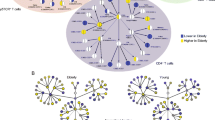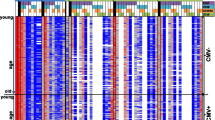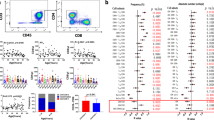Abstract
It has been suggested that γδ T cells are involved in certain autoimmune disorders. To establish reference data for clinical studies to explore the role of γδ T cells in autoimmune bone marrow failure syndrome, we examined the γδ T-cell repertoire in 120 healthy Japanese individuals by flow cytometry. The average numbers of T lymphocytes in blood were as follows: 1,084 ± 369 (SD) αβ T cells, 68 ± 44 γδ T cells, 16 ± 12 Vδ1 T cells, and 43 ± 36 Vδ2 T cells (/μl). Absolute numbers of γδ T cells decreased with aging (R = −0.378, P < 0.001). The decrease of γδ T cells was the result of reduction of Vδ2, but not of Vδ1, T cells. Numbers of Vδ2 T cells were significantly higher in male than in female donors (P = 0.007). The Vδ2 T cells but not Vδ1 T cells showed a rapid reduction in cell numbers on mitogen stimulation, which was accompanied by modest down-regulation of Bcl-2 protein expression. These results indicate that age and gender have a major impact on γδ T-cell repertoire in Japanese donors, as well as European and American donors. The age-related decrease of Vδ2 T cells may be explained by their susceptibility to activation-induced cell death.







Similar content being viewed by others
References
Loughran TP Jr. Clonal diseases of large granular lymphocytes. Blood. 1993;82:1–14.
Go RS, Tefferi A, Li CY, Lust JA, Phyliky RL. Lymphoproliferative disease of granular T lymphocytes presenting as aplastic anemia. Blood. 2000;96:3644–66.
Go RS, Li CY, Tefferi A, Phyliky RL. Acquired pure red cell aplasia associated with lymphoproliferative disease of granular T lymphocytes. Blood. 2001;98:483–5.
Fujishima M, Sawada K, Hirokawa M, Oshimi K, Sugimoto K, Matsuda A, et al. Long-term responses and outcomes following immunosuppressive therapy in large granular lymphocyte leukemia-associated pure red cell aplasia: a nationwide cohort study in Japan for the PRCA Collaborative Study Group. Haematologica. 2008;93:1555–9.
Zeng W, Nakao S, Takamatsu H, Yachie A, Takami A, Kondo Y, et al. Characterization of T-cell repertoire of the bone marrow in immune-mediated aplastic anemia: evidence for the involvement of antigen-driven T-cell response in cyclosporine-dependent aplastic anemia. Blood. 1999;93:3008–16.
Risitano AM, Maciejewski JP, Green S, Plasilova M, Zeng W, Young NS. In vivo dominant immune responses in aplastic anaemia: molecular tracking of putatively pathogenetic T-cell clones by TCR beta-CDR3 sequencing. Lancet. 2004;364:355–64.
de Vries AC, Langerak AW, Verhaaf B, Niemeyer CM, Stary J, Schmiegelow K, et al. T-cell receptor Vbeta CDR3 oligoclonality frequently occurs in childhood refractory cytopenia (MDS-RC) and severe aplastic anemia. Leukemia. 2008;22:1170–4.
Holoshitz J, Koning F, Coligan JE, De Bruyn J, Strober S. Isolation of CD4- CD8- mycobacteria-reactive T lymphocyte clones from rheumatoid arthritis synovial fluid. Nature. 1989;339:226–9.
Horiuchi T, Hirokawa M, Satoh K, Kitabayashi A, Muira AB. Clonal expansion of gammadelta-T lymphocytes in an HTLV-I carrier, associated with chronic neutropenia and rheumatoid arthritis. Ann Hematol. 1999;78:101–4.
Sutton CE, Lalor SJ, Sweeney CM, Brereton CF, Lavelle EC, Mills KH. Interleukin-1 and IL-23 induce innate IL-17 production from γδ T cells, amplifying Th17 responses and autoimmunity. Immunity. 2009;31:331–41.
Handgretinger R, Geiselhart A, Moris A, Grau R, Teuffel O, Bethge W, et al. Pure red-cell aplasia associated with clonal expansion of granular lymphocytes expressing killer-cell inhibitory receptors. N Engl J Med. 1999;340:278–84.
Fujishima N, Hirokawa M, Fujishima M, Wada C, Toyoshima I, Watanabe S, et al. Oligoclonal T cell expansion in blood but not in the thymus from a patient with thymoma-associated pure red cell aplasia. Haematologica. 2006;91(12 Suppl):ECR47.
Parker CM, Groh V, Band H, Porcelli SA, Morita C, Fabbi M, et al. Evidence for extrathymic changes in the T cell receptor gamma/delta repertoire. J Exp Med. 1990;171:1597–612.
Cairo C, Armstrong CL, Cummings JS, Deetz CO, Tan M, Lu C, et al. Impact of age, gender, and race on circulating γδ T cells. Human Immunol. 2010;71:968–75.
Renzi P, Ginns LC. Analysis of T cell subsets in normal adults. Comparison of whole blood lysis technique to Ficoll-Hypaque separation by flow cytometry. J Immunol Methods. 1987;98:53–6.
Nishimura H, Hirokawa M, Fujishima N, Fujishima M, Miura I, Sawada K. Contribution of complementarity-determining region 3 of the T-cell receptor Vdelta2 chain to the recognition of aminobisphosphonates by human gammadelta T-cells. Int J Hematol. 2004;79:369–76.
Hildeman DA, Zhu Y, Mitchell TC, Bouillet P, Strasser A, Kappler J, et al. Activated T cell death in vivo mediated by proapoptotic bcl-2 family member bim. Immunity. 2002;16:759–67.
Hildeman DA, Mitchell T, Aronow B, Wojciechowski S, Kappler J, Marrack P. Control of Bcl-2 expression by reactive oxygen species. Proc Natl Acad Sci USA. 2003;100:15035–40.
Ho S, Campana D. Phenotypic changes and proliferative activity of human γδ T cell receptor-bearing cells upon activation. Clin Exp Immunol. 1991;84:376–82.
Janssen O, Wesselborg S, Heckl-Ostreicher B, Pechhold K, Bender A, Schondelmaier S, et al. T cell receptor/CD3-signaling induces death by apoptosis in human T cell receptor γδ + T cells. J Immunol. 1991;146:35–9.
Wesselborg S, Janssen O, Kabelitz D. Induction of activation-driven death (apoptosis) in activated but not resting peripheral blood T cells. J Immunol. 1993;150:4338–45.
Xu L, Zhang L, Bertucci AM, Pope RM, Datta SK. Apigenin, a dietary flavonoid, sensitizes human T cells for activation-induced cell death by inhibiting PKB/Akt and NF-kB activation pathway. Immunol Lett. 2008;121:74–83.
Snow AL, Oliveira JB, Zheng L, Dale JK, Fleisher TA, Lenardo MJ. Critical role for BIM in T cell receptor restimulation-induced death. Biol Direct. 2008;3:34.
Bouillet P, Purton JF, Godfrey DI, Zhang LC, Coultas L, Puthalakath H, Pellegrini M, et al. BH3-only Bcl-2 family member Bim is required for apoptosis of autoreactive thymocytes. Nature. 2002;415:922–6.
Groh V, Steinle A, Bauer S, Spies T. Recognition of stress-induced MHC molecules by intestinal epithelial γδ T cells. Science. 1998;279:1737–40.
Argentati K, Re F, Donnini A, Tucci MG, Franceschi C, Bartozzi B, et al. Numerical and functional alterations of circulating γδ T lymphocytes in aged people and centenarians. J Leukoc Biol. 2002;72:65–71.
Caccamo N, Dieli F, Wesch D, Jomaa H, Eberl M. Sex-specific phenotypical and functional differences in peripheral human Vgamma9/Vdelta2 T cells. J Leukoc Biol. 2006;79:663–6.
Senju M, Makiyama K, Hara K, Hulstaert F, Lowder JN, Jewell DP. Two-color immunofluorescence and flow cytometric analysis of peripheral blood lymphocyte subsets in Caucasian and Japanese healthy subjects. Jpn J Med. 1991;30:509–15.
Li B, Bassiri H, Rossman MD, Kramer P, Eyuboglu AF, Torres M, et al. Involvement of the Fas/Fas ligand pathway in activation-induced cell death of mycobacteria-reactive human gamma delta T cells: a mechanism for the loss of gamma delta T cells in patients with pulmonary tuberculosis. J Immunol. 1998;161:1558–67.
Ju ST, Panka DJ, Cui H, Ettinger R, el-Khatib M, Sherr DH, et al. Fas(CD95)/FasL interactions required for programmed cell death after T-cell activation. Nature. 1995;373:444–8.
Alderson MR, Tough TW, Davis-Smith T, Braddy S, Falk B, Schooley KA, et al. Fas ligand mediates activation-induced cell death in human T lymphocytes. J Exp Med. 1995;181:71–7.
Bosque A, Pardo J, Martinez-Lorenzo MJ, Iturralde M, Marzo I, Piñeiro A, et al. Down-regulation of normal human T cell blast activation: roles of APO2L/TRAIL, FasL, and c-FLIP, Bim, or Bcl-x isoform expression. J Leukoc Biol. 2005;77:568–78.
Willis SN, Adams JM. Life in the balance: how BH3-only proteins induce apoptosis. Curr Opin Cell Biol. 2005;17:617–25.
Kawahara A, Kobayashi T, Nagata S. Inhibition of Fas-induced apoptosis by Bcl-2. Oncogene. 1998;17:2549–54.
Pitard V, Roumanes D, Lafarge X, Couzi L, Garrigue I, Lafon ME, et al. Long-term expansion of effector/memory Vδ2-γδ T cells is a specific blood signature of CMV infection. Blood. 2008;112:1317–24.
Dechanet J, Merville P, Lim A, Retière C, Pitard V, Lafarge X, et al. Implication of γδ T cells in the human immune response to cytomegalovirus. J Clin Invest. 1999;103:1437–49.
Vermijlen D, Brouwer M, Donner C, Liesnard C, Tackoen M, Van Rysselberge M, et al. Human cytomegalovirus elicits feta γδ T cell responses in utero. J Exp Med. 2010;207:807–21.
Fujishima N, Hirokawa M, Fujishima M, Yamashita J, Saitoh H, Ichikawa Y, et al. Skewed T cell receptor repertoire of Vδ1 + γδ T lymphocytes after human allogeneic haematopoietic stem cell transplantation and the potential role for Epstein–Barr virus-infected B cells in clonal restriction. Clin Exp Immunol. 2007;149:70–9.
Bacigalupo A, Passweg J. Diagnosis and treatment of acquired aplastic anemia. Hematol Oncol Clin North Am. 2009;23:159–70.
Rosenfeld S, Follmann D, Nunez O, Young NS. Antithymocyte globulin and cyclosporine for severe aplastic anemia: association between hematologic response and long-term outcome. JAMA. 2003;289:1130–5.
Sawada K, Hirokawa M, Fujishima N, Teramura M, Bessho M, Dan K, et al. Long-term relapse-free survival and overall survival of patients with acquired primary idiopathic PRCA receiving cyclosporine A. A nationwide cohort study in Japan for the PRCA Collaborative Study Group. Haematologica. 2007;92:1021–8.
Hirokawa M, Sawada K, Fujishima N, Nakao S, Urabe A, Dan K, et al. Long-term response and outcome following immunosuppressive therapy in thymoma-associated pure red cell aplasia: a nationwide cohort study in Japan for the PRCA Collaborative Study Group. Haematologica. 2008;93:27–33.
Sawada K, Fujishima N, Hirokawa M. Acquired pure red cell aplasia: updated review of treatment. Brit J Haematol. 2008;142:505–14.
Acknowledgments
This work was supported by grants from the Ministry of Education, Science, Sports and Culture of Japan (MH, 22591024; KS, 20591144), funds from the “Global Center of Excellence Program (COE)” of the Ministry of Education, Science, Technology, Sports and Culture of Japan, and a research grant from the Idiopathic Disorders of Hematopoietic Organs Research Committee of the Ministry of Health, Labour and Welfare of Japan. The authors are grateful to Hiromi Kataho and Etsuko Kobayashi (Department of Hematology, Nephrology and Rheumatology, Akita University Graduate School of Medicine) for their valuable technical assistance.
Author information
Authors and Affiliations
Corresponding author
Electronic supplementary material
Below is the link to the electronic supplementary material.
Supplementary Figure S1. Comparison of absolute lymphocyte numbers by different methods. Statistical significance was determined by Student’s t-test.
About this article
Cite this article
Michishita, Y., Hirokawa, M., Guo, YM. et al. Age-associated alteration of γδ T-cell repertoire and different profiles of activation-induced death of Vδ1 and Vδ2 T cells. Int J Hematol 94, 230–240 (2011). https://doi.org/10.1007/s12185-011-0907-7
Received:
Revised:
Accepted:
Published:
Issue Date:
DOI: https://doi.org/10.1007/s12185-011-0907-7




